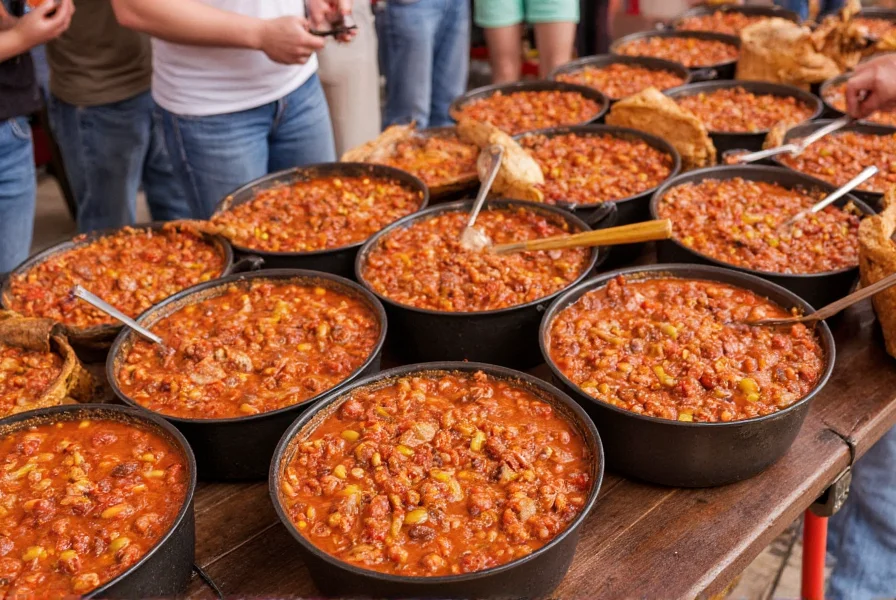Texas chili stands as a culinary emblem of the Lone Star State, defined by its simplicity and bold flavors. Unlike other regional chili varieties, authentic Texas-style chili contains no beans—a point of pride among Texans who view beans as filler that dilutes the pure meat essence. The foundation is beef (typically chuck roast or brisket), dried chili peppers like ancho and guajillo, and a blend of spices simmered for hours to develop deep, complex flavors. This meat-centric approach creates a thick, hearty stew where the beef shines, not hidden beneath beans or tomato paste.
The Origins of Texas Chili
Texas chili traces its roots to the late 19th century, when Mexican immigrants and Texas cowboys developed portable, protein-rich meals using available ingredients. Chili queens in San Antonio sold “chili con carne” from street carts as early as the 1880s, establishing the dish’s cultural foothold. The 1937 Texas Centennial Exposition popularized it statewide, and by the mid-20th century, chili cook-offs became a Texas tradition. The International Chili Society, founded in 1967, cemented strict guidelines for authentic preparation, notably banning beans in competition categories.
What Makes Texas Chili Unique
Three elements define authentic Texas chili:
- Zero beans—A non-negotiable rule separating it from “regular” chili
- Beef as the star—Chuck roast, brisket, or coarsely ground beef
- Dried chili peppers—Not just chili powder; whole peppers like New Mexico or pasilla are toasted and rehydrated
The texture comes from slow reduction, not thickeners. As the meat simmers for 4–8 hours, collagen breaks down, creating a naturally thick, meaty consistency. Tomatoes are generally avoided, though some modern variations include a small amount for acidity.
| Chili Style | Key Ingredients | Beans? | Texture |
|---|---|---|---|
| Texas Chili | Beef, dried chilies, cumin, garlic | No | Thick, meat-focused, no fillers |
| Cincinnati Chili | Ground beef, Mediterranean spices, cocoa | No | Thin, served over spaghetti |
| Regular/Bean Chili | Ground beef, beans, tomato paste | Yes | Thinner, common nationwide |
Texas Chili vs. Other Regional Varieties
While Cincinnati chili features Mediterranean spices and is served over spaghetti, and Midwestern chili often includes beans and tomatoes, Texas chili remains strictly meat-forward. New Mexico chili focuses on fresh green chilies rather than dried, and Colorado chili sometimes includes pork but still avoids beans. The “bean debate” is particularly heated—in Texas, adding beans to chili is often jokingly called “a felony.”

Traditional Preparation Techniques
Making authentic Texas chili requires patience and attention to detail:
- Meat selection—Use well-marbled cuts like chuck roast, cut into 1-inch cubes
- Chili pepper prep—Toast dried chilies, remove seeds, and simmer in broth to rehydrate before blending into a smooth paste
- Slow cooking—Simmer meat and chili paste for 4–8 hours, skimming fat periodically
- Seasoning balance—Cumin is essential, but avoid overpowering the chili pepper flavors
Many Texans swear by the “Dutch oven method,” cooking chili outdoors over mesquite wood to infuse smoky notes. The finished product should have a deep red color, rich aroma, and a consistency where the meat fibers are distinct but tender.
Serving Traditions and Modern Variations
In Texas, chili is typically served as a main dish in a bowl, accompanied by simple sides that don’t compete with its robust flavor. Common pairings include:
- Saltine crackers or cornbread for dipping
- Shredded cheddar cheese
- Raw white onions
- Sour cream
Modern interpretations sometimes include a splash of beer or coffee for depth, but purists argue these additions stray from tradition. The Texas State Legislature even passed a resolution in 1977 declaring chili the “official dish of Texas,” underscoring its cultural significance.

Common Misconceptions
Several myths persist about Texas chili:
- “All chili has beans”—Historically inaccurate; beans were added later in other regions
- “Tomato paste is essential”—Traditional recipes omit tomatoes to highlight meat and chili flavors
- “Chili powder is the main seasoning”—Authentic versions use whole dried chilies, not pre-mixed powder
Understanding these distinctions helps preserve the integrity of this Texas culinary tradition. Whether enjoyed at a backyard gathering or a competitive cook-off, authentic Texas chili remains a celebration of simplicity and bold flavors.
Frequently Asked Questions
Why is there no beans in authentic Texas chili?
Beans were historically viewed as fillers that diluted the pure meat flavor Texans prized. The “no beans” rule became a cultural identifier, distinguishing Texas chili from other regional varieties. In 1951, the San Antonio Chili Stand Association formally declared beans inappropriate for authentic Texas-style chili.
What cut of beef is best for Texas chili?
Beef chuck roast is the traditional choice due to its marbling and connective tissue, which breaks down during slow cooking to create rich flavor and texture. Some variations use brisket (a Texas barbecue staple) or coarsely ground beef, but ground meat alone lacks the depth of cubed cuts.
How long should Texas chili simmer?
Authentic Texas chili requires 4–8 hours of gentle simmering. This extended cooking time allows collagen in the meat to convert to gelatin, creating a naturally thick consistency without beans or thickeners. Many pitmasters recommend an overnight simmer for optimal flavor development.
Can I use chili powder instead of dried peppers?
While convenient, pre-mixed chili powder lacks the complexity of rehydrated dried chilies. For authentic flavor, toast and rehydrate whole dried peppers (like ancho, guajillo, and New Mexico) before blending into a paste. If using powder, choose a high-quality brand with minimal additives.
How do Texans traditionally serve chili?
In Texas, chili is served as a standalone dish in a bowl, often with simple accompaniments: saltine crackers for texture, shredded cheddar for richness, raw onions for brightness, and sour cream for cooling. It’s rarely served with rice or beans, which would contradict its “no beans” principle.











 浙公网安备
33010002000092号
浙公网安备
33010002000092号 浙B2-20120091-4
浙B2-20120091-4